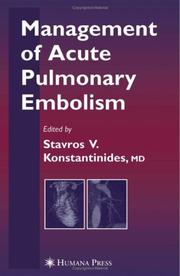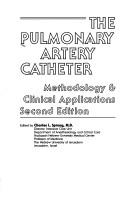| Listing 1 - 10 of 22 | << page >> |
Sort by
|
Book
ISBN: 1846920531 9786612093920 1282093924 1846926106 9781846926105 9781846920530 9781282093928 Year: 2009 Publisher: Oxford : Atlas Medical Publishing Ltd,
Abstract | Keywords | Export | Availability | Bookmark
 Loading...
Loading...Choose an application
- Reference Manager
- EndNote
- RefWorks (Direct export to RefWorks)
Pulmonary arterial hypertension (PAH) is a rare condition; yet this very rarity can be a disadvantage when it comes to treatment, making PAH difficult to diagnose, and resulting in suboptimal patient care. Furthermore, the global burden of PAH remains poorly understood and largely underestimated, as PAH commonly presents as a comorbidity with such conditions as systemic sclerosis, COPD, idiopathic pulmonary fibrosis and left-heart dysfunction. However, in recent years there has been significant investment in developing new therapies for PAH, and treatment for this previously neglected disease
Hypertension, Pulmonary. --- Pulmonary artery. --- Pulmonary hypertension.
Dissertation
Abstract | Keywords | Export | Availability | Bookmark
 Loading...
Loading...Choose an application
- Reference Manager
- EndNote
- RefWorks (Direct export to RefWorks)
Aorta --- Blood Vessel Prosthesis. --- Pulmonary Artery --- Surgery.
Dissertation
Abstract | Keywords | Export | Availability | Bookmark
 Loading...
Loading...Choose an application
- Reference Manager
- EndNote
- RefWorks (Direct export to RefWorks)
Aorta --- Pulmonary Artery --- Blood Vessel Prosthesis --- surgery
Book
Abstract | Keywords | Export | Availability | Bookmark
 Loading...
Loading...Choose an application
- Reference Manager
- EndNote
- RefWorks (Direct export to RefWorks)
Hypertension, Pulmonary --- Pulmonary Artery --- Pulmonary Veins --- pathology
Dissertation
Abstract | Keywords | Export | Availability | Bookmark
 Loading...
Loading...Choose an application
- Reference Manager
- EndNote
- RefWorks (Direct export to RefWorks)
Blood Vessels --- Brachial Artery --- Pulmonary Artery --- embryology

ISBN: 1280971916 9786610971916 1597452874 158829644X Year: 2007 Publisher: Totowa, N.J. : Humana Press,
Abstract | Keywords | Export | Availability | Bookmark
 Loading...
Loading...Choose an application
- Reference Manager
- EndNote
- RefWorks (Direct export to RefWorks)
Management of Acute Pulmonary Embolism highlights traditional, novel, and evolving aspects of the diagnosis and treatment of pulmonary embolism (PE). The contributors comprise an international team of experts, who have each made noteworthy contributions in this exciting field. Important aspects of diagnosis, risk stratification, and differential treatment of patients with PE are presented in a concise, yet comprehensive manner. Emphasis is placed on specific issues related to PE, including pregnancy, cancer, thrombophilia, and air travel. The authors critically review and interpret available data, and provide clear recommendations for diagnosis and therapeutic concerns in clinical management of PE patients. Management of Acute Pulmonary Embolism is organized in three precise sections - diagnosis, treatment, and special topics. Each section is up-to-date and detailed, and provides clear recommendations for diagnostic and therapeutic approaches to patients with PE in clinical practice. This practical volume is an essential starting point for future study for both medical students and established investigators.
Pulmonary embolism. --- Pulmonary embolism --- Treatment. --- Embolism --- Pulmonary artery --- Diseases
Book
ISBN: 9535168762 9535102338 Year: 2012 Publisher: IntechOpen
Abstract | Keywords | Export | Availability | Bookmark
 Loading...
Loading...Choose an application
- Reference Manager
- EndNote
- RefWorks (Direct export to RefWorks)
Pulmonary embolism is a serious, potentially life-threatening cardiopulmonary disease that occurs due to partial or total obstruction of the pulmonary arterial bed. Recently, new improvement occurred in the diagnosis and treatment of the disease. The aim of this disease is to re-review pulmonary embolism in the light of new developments. In this book, in addition to risk factors causing pulmonary embolus, a guide for systematic approaches to lead the risk stratification for decision making is also presented. In order to provide a maximum length of active life and continuation of functional abilities as the aim of new interventional gerontology, the risk factors causing pulmonary embolus in elderly individuals are evaluated, and the approach to prevention and treatment are defined. The risk of the development of deep vein thrombosis and pulmonary embolism, combined with obesity due to immobility, the disease of this era, irregular and excessive eating, and treatment management are highlighted. Non-thrombotic pulmonary emboli are also covered and an attempt is made to constitute an awareness of this picture that can change the treatment and prognosis of the disease to a considerable extent. In addition to the pathophysiological definition of pulmonary embolus, the priority goal of quick and definitive diagnosis is emphasized, and diagnostic strategies are discussed in the book. A numerical analysis of the vena cava filters, which is a current approach to prevent pulmonary emboli recurrences, is presented in the last chapter.
Pulmonary embolism. --- Embolism --- Pulmonary artery --- Diseases --- Respiratory medicine
Book
ISBN: 1839699671 Year: 2022 Publisher: London : IntechOpen,
Abstract | Keywords | Export | Availability | Bookmark
 Loading...
Loading...Choose an application
- Reference Manager
- EndNote
- RefWorks (Direct export to RefWorks)
Thromboembolism is the most common cause of death in autopsied patients. Recently, this disorder has become a topic of interest due to it being a frequent complication of COVID-19 infection. This book discusses pulmonary thromboembolism in COVID-19 and non-COVID-19 patients, such as those with malignancies such as paraneoplastic symptoms or heart and lung diseases.
Pulmonary embolism. --- Thromboembolism. --- Embolism --- Thrombosis --- Pulmonary artery --- Diseases

ISBN: 0963731505 Year: 1993 Publisher: Closter, N.J. : Critical Care Research Associates,
Abstract | Keywords | Export | Availability | Bookmark
 Loading...
Loading...Choose an application
- Reference Manager
- EndNote
- RefWorks (Direct export to RefWorks)
Pulmonary artery --- Cardiac Catheterization. --- Pulmonary Wedge Pressure. --- Catheterization
Dissertation
Abstract | Keywords | Export | Availability | Bookmark
 Loading...
Loading...Choose an application
- Reference Manager
- EndNote
- RefWorks (Direct export to RefWorks)
Pulmonary Artery --- Cardiac Output --- Hemodynamics --- Echocardiography, Transesophageal --- ultrasonography --- physiology
| Listing 1 - 10 of 22 | << page >> |
Sort by
|

 Search
Search Feedback
Feedback About UniCat
About UniCat  Help
Help News
News